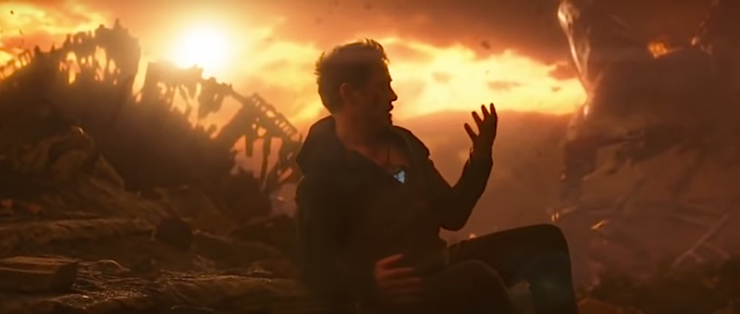We were talking about how the remaining Avengers found Fury’s beeper.
Let me back up. The ending of Avengers: Infinity War draws on imagery from a rather surprising corner of popular culture, and I want to dig into it, but but I’ll need to get into very spoilery territory for the Avengers: Infinity War and Captain Marvel, so click through only if you’re caught up!
In the post credits scene of Captain Marvel, it’s revealed that someone found Nick Fury’s souped-up beeper and gave it to the Avengers, who are holding it at their HQ. They speculate about who—or what—the beeper is contacting. Then Carol Danvers walks into the room, and I don’t know what happened next because my theater erupted in so much noise I blacked out for a second.
But the next day, batting the movie around the Tor.com office, it occurred to us: who found the beeper? Or maybe more important: how did they know it was significant? Obviously the Avengers could find Fury’s car (presumably he and the other S.H.I.E.L.D. agents have tracking elements installed) but he dropped the beeper a few feet away, so how did anyone know it was his? In the panic and confusion after the Snapture, how did someone happen to look down, notice a beeper, and realize it was important?
I joked that maybe Nick Fury’s eyepatch hadn’t dusted, and had wafted to ground on top of the beeper, thus giving the Avengers the clue they needed that this was Fury’s last message.
But that took us down a different rabbit hole entirely: why didn’t the beeper dust? When people dusted their clothes went with them, but T’Challa and Bucky were both holding weapons that stayed behind. Where’s the line? If you’re wearing gloves and driving, say, why would the gloves dust but the steering wheel wouldn’t? If the point is that Thanos is wiping out 50% of all life, is this implying that your clothing is alive in some way? I mean, Dr. Strange’s Cloak of Levitation is sentient, but Star-Lord’s pants?
This nagged at me for a while until I realized that was bothering me was a twist on the visual language of disappearance. Essentially, the MCU has created a secular Rapture movie.
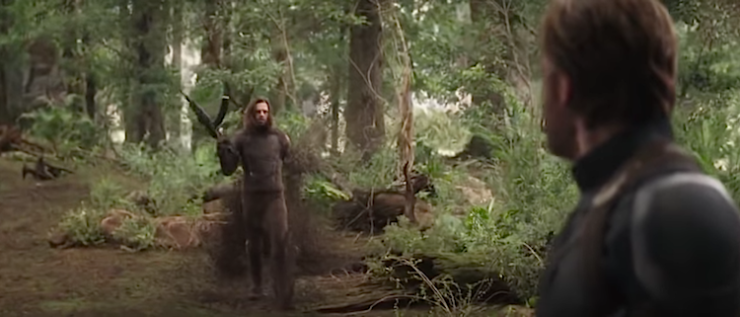
When Glen Weldon coined the term “Snapture” in his NPR review of Infinity War, I was furious with myself for not thinking of it first. It’s such a perfect, succinct merging of two different pop cultures! And the more I thought about it the more intrigued I became by how the MCU used the imagery of disappearance. (And I’m summarily rejecting Feige’s preferred term of “Decimation” btw—a decimation is taking out a tenth of a population, not a whole-ass 50%.)
And thus I have come to explain the differences between the Snapture and the Rapture.
The Rapture is a very particular idea of the End Times, tied to a very particular branch of Christianity. It’s rooted in two passages in the New Testament, one from the Gospel of Matthew 24:37-40, NRSV :
For as the days of Noah were, so will be the coming of the Son of Man. For as in those days before the flood they were eating and drinking, marrying and giving in marriage, until the day Noah entered the ark, and they knew nothing until the flood came and swept them all away, so too will be the coming of the Son of Man. Then two will be in the field; one will be taken and one will be left.
The other is from Paul’s Letter to the Thessalonians—1 Thessalonians 4:15-17, NRSV:
For this we declare to you by the word of the Lord, that we who are alive, who are left until the coming of the Lord, will by no means precede those who have died. For the Lord himself, with a cry of command, with the archangel’s call and with the sound of God’s trumpet, will descend from heaven, and the dead in Christ will rise first. Then we who are alive, who are left, will be caught up in the clouds together with them to meet the Lord in the air; and so we will be with the Lord forever.
The paragraph in Matthew is doing a ton of work. First we get a callback to the story of Noah, grounding the listener/reader in history, and the Flood is invoked as a metaphor for how abrupt and shocking the end times will be. Finally, we get the line that a lot of people have spent the last couple millennia arguing about: “That is how it will be at the coming of the Son of Man. Two men will be in the field; one will be taken and the other left.”
And as for Thessalonians—the idea seems to be that Paul didn’t want currently-alive Christians to think that they would be reunited with Christ before the faithful dead? (Either to reassure them that their deceased loved ones wouldn’t be forgotten, or to keep them from thinking they were more worthy of meeting Christ than those who had already died—I’m not even sure how this would have come up, but here we are.) The thing that a lot of people got stuck on, however, was that phrase “we who are still alive and are left will be caught up together with them in the clouds to meet the Lord in the air.” This led to the popular Rapture imagery of people being swept up into the air along with the souls of the dead.
This image captivated Christian theologians. As ideas about the End Times were debated and turned into art, people fixated on the starkness of these passages, creating an extremely dramatic idea of the end: people abruptly snatched out of their lives to join all of the faithful in the air, while everyone else is left on Earth.
Why the obsession with the end? Christianity began life as an apocalyptic cult, and people believed that the world was going to end any moment. A lot (like a lot) of early Christian writing is about living a pure life in order to be ready for the end. There were also (probably) at least a few waves of persecution, which led to writings like The Revelation of John, which was (probably) a coded account of the Emperor Domitian and/or Nero, and many of the earliest Church writings and oral culture in general revolving around public torture and executions. (I’m adding all of these ‘probablies’ because it’s extremely hard to confirm what really went on in those centuries, as the intervening histories have all been written by the winner, Christianity.) As the decades rolled on, though, the young religion had to find ways to fold itself into ordinary life, which necessarily meant losing some of its initial urgency. This in turn meant that every few years a reform movement would rise with the intention of taking Christianity back to its roots. Over the centuries this has happened on giant scales and tiny—the one you’ve probably heard of is the Protestant Reformation. But even that Reformation has since inspired wave after wave of groups who have decided that Protestantism needs to be reformed all over again—which is why if you look Protestantism up online you’ll find roughly 12 billion different denominations.
Quite a few would-be reformers have found that one of the easiest ways to bring Christianity back to its roots is to un-cancel the Apocalypse. In the early 1800s a Church of Ireland priest named John Nelson Darby quit the established church (believing that it had strayed too far from the Scriptures, just as Martin Luther previously believed about, well, all of Catholicism) and developed a particular view of the end of the world called Premillennial Dispensationalism.
- “Millennialism” = the belief that Jesus is, eventually, going to have a 1,000-year reign on Earth that will be pretty great (avocado toast, student debt cancellation, all the things Millennials love!)
- “Dispensationalism” = life on Earth is unfolding as a series of eras—or “dispensations”—that are telling a story.
(Sort of like how we’re coming to the end of Marvel’s Phase Three right now, but can make some predictions for Phase Four based on how the bigger story of Thanos has played out.)
Darby theorized that the Rapture would come before life got too terrible, but that things would go downhill fast immediately after it. This is Pre-Tribulation Premillennialism—the idea that the end of the world starts with the Rapture, continues through seven years of natural disasters, wars, and plagues called the “Tribulation,” and then ends with the Second Coming. The Second Coming starts a Millennium of peace, and marks the last “dispensation.”
This idea was appealing to Christians who felt that life on Earth was going pear-shaped, but who didn’t necessarily want to stick around for the worst of it. But where there is theology there is argument, so over the decades ministers and preachers hashed out several variations on the Rapture and the End Times, including:
- Mid-Tribulational Premillennialism and Prewrath Premillennialism: the Rapture will happen at some point during the Tribulation.
- Partial Pre-Tribulation Premillennialism: people will be raptured in groups, either based on the timing of their conversion to Christianity, or by the strength of their relationship with God.
- Post-Tribulational Premillennialism, in which the Rapture comes after the Tribulation, with everyone, faithful Christian or no, suffering through the crappiness of the End Times.
Another thing to keep in mind: at some point during the Tribulation the anti-Christ will appear and come into power, kicking off Armageddon, which ends when Jesus comes back and defeats the anti-Christ.
Casting Endgame through any one of these lenses would be fascinating—is the Age of Marvels a Tribulation? We’ve already had an Armageddon of sorts in Thor: Ragnarok, but the battle between good and evil the remaining Avengers and Thanos, looms on the horizon. But will that battle undo the Snapture? Will Phase Four last 1,000 years?

Rapture theories were a big part of evangelical culture in the early 20th Century, but it wasn’t until the end of the 1960s that Rapture imagery began hitting pop culture. Unsurprisingly, most of the examples fall on the Christian side of the entertainment world, but I’ll cover all the biggest hits.
In 1969, Larry Norman recorded what is considered the first real Christian rock album, Upon This Rock (which, just, I aspire to that level of pun) and included a song, “I Wish We’d All Been Ready” that features a nod to Matthew:
A man and wife asleep in bed
She hears a noise and turns her head he’s gone
I wish we’d all been ready
Two men walking up a hill
One disappears and one’s left standing still
I wish we’d all been ready
You get the idea. The Rapture got even more coverage when Hal Lindsey’s book The Late, Great Planet Earth became a surprise bestseller in 1970. Lindsey theorized that the current dispensation was going to end in the 1980s, and that humanity was embarking on its last decade before the End Times. (While he stopped short of setting a date, he did imply that Jesus would probably come back by 1988.) The book was massively popular, becoming the first book of Christian prophecy to be published by a secular house when Bantam reissued it in 1973. Orson Welles even narrated the film adaptation, in what could be considered a sequel to his own Apocalyptic War of the Worlds broadcast.
In the meantime, the 1972 film A Thief in the Night took the next, most obvious step, and applied sci-fi and horror tropes to a Rapture story: A woman named Patty wakes up to find that her husband and family have all disappeared. She finds her husband’s electric razor buzzing in the sink, a lawnmower whirs on their Raptured neighbor’s yard, a Raptured kid’s stuffed animal rolls down an empty sidewalk. News announcers inexplicably read from the Matthew and Thessalonians passages rather than reporting on the numbers of disappeared.
The anti-Christ takes over the government immediately, and his army of Midwesterners roll out in minivans to hunt Patty down and tattoo her hand with “666” in binary. In the sequels to the film, the Tribulation worsens, the remaining humans are devastated by nuclear war, and the series culminates in a last stand by the anti-Christ before the final battle between the forces of good and evil.

A Thief in the Night became a giant cultural touchstone among the next two generations of Evangelical Christians, until it was largely replaced in the cultural consciousness by the next wave of Rapture fiction, the Left Behind series.
The first film adaptation of Left Behind created a far more dramatic visual language. In the opening scene, an elderly woman wakes during a night flight and realizes her husband is gone. She freaks out, which seems odd—as a fellow passenger points out, he probably just gone to the restroom. But we eventually see the reason for her dismay as the camera pans down to reveal her husband’s full suit lying empty on the seat. As the scene unfolds and the flight attendant finally turns the cabin lights on, we see that there are clothes left on about half the seats, often with glasses or crosses lying on top of them.
The movie then cuts to a scene of chaos that’s become a disaster movie standard as a shocked teen wanders through a pile-up on the highway, cars and buses on fire around her, drivers and passengers trying to make sense of suddenly driver-less vehicles veering out of control.
The Leftovers, a more secular approach to the topic based on a novel by Tom Perrotta, splits the difference, visually speaking. In the opening scene, we see a mother trying to do laundry as her baby cries in a bassinet. The camera follows her from the Laundromat to her car, where she tries to soothe the baby, the camera panning between her seat in the front and the baby’s in the back. When the cries stop it’s a relief, until the camera follows her eyes, pans back, and reveals the empty bassinet. She screams for her child, and is echoed by a child yelling for his disappeared dad as a shopping cart rolls away. Finally, as the camera pans all the way around, we see a driverless car skid into the parking lot and hit a wall.
The nature of other disappearances are revealed throughout the show, but they always involve the person simply going poof, taking their clothing with them, but not objects they were holding.
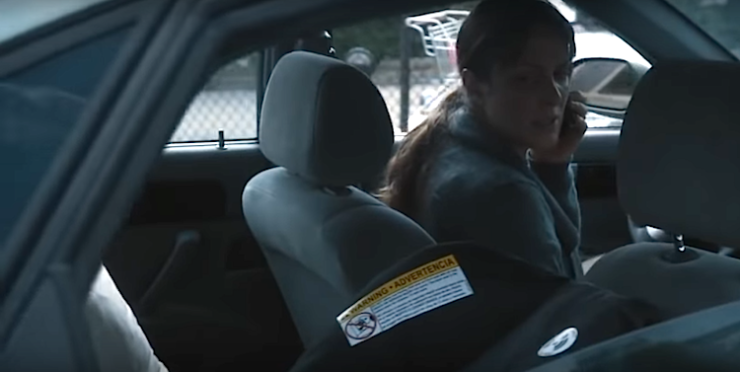
Infinity War created a fascinating mash up in its language of disappearance. People don’t simply vanish, instead the films draws on the dusting imagery more common to vampire media. Buffy the Vampire Slayer used dusting because the show couldn’t very well spend the last fifteen minutes of every episode following a teenage girl’s adventures in vampire corpse disposal. And the vampires in Blade dusted because, and I’m gonna go out on a limb here, it looked cool as shit. In this way both series followed the lead of video games, which tend to disappear the bodies of vanquished foes so they don’t clutter up the screen (and so you don’t realize that you’re kind of a murderer) with the occasional dramatic dusting or explosion to drag out the death of important characters.
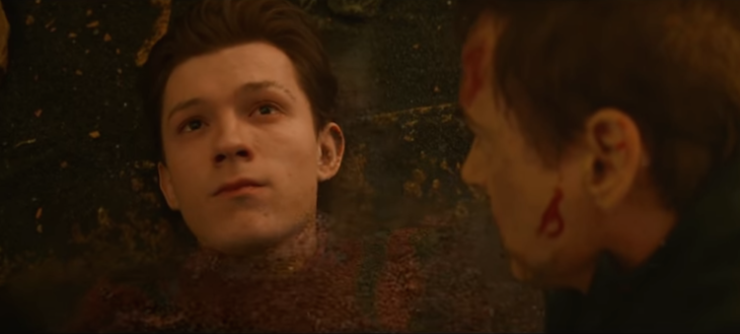
Infinity War splits the difference in its language. People watched their heroes crumble into dust as in vampire fiction, but then lingered on the horror of those left behind, as in Rapture fiction. Some dusted without a word, while others had time for a last message. And finally, in the post-credits scene, we have a moment that calls back to both Left Behind and The Leftovers. Nick Fury and Maria Hill are on the road, discussing the alien ships over Wakanda, when a car goes out of control right in front of them. Hill runs to check on the driver, but finds an empty seat. Other cars ricochet into buildings. A helicopter spins into a high rise. We, the audience, know what’s going on, but none of these people on the ground know who Thanos is, or that the Avengers failed—even Fury and Hill are helpless as chaos erupts around them. And as Rapture fiction discovered decades ago, nothing shows this sort of terror like an ordinary fact of life: driving down a highway, mowing the lawn, doing laundry, becoming suddenly uncanny. And this visual language does its work: by the time Fury’s beeper is on the ground, we’ve accepted that life on Earth has been disrupted in an unprecedented way, and we’re primed to watch the aftermath in Endgame.
The emotional core of the Snapture is the same as its religious counterpart: people we love vanish because of the actions of an almighty being. Morally, however, things get far knottier. Where The Rapture is based solidly in a predetermined system of judgment, the Snapture is random. Thanos has no personal grudge or favor toward any of them, and they didn’t break any rules he set—that would be his minion Ronan’s bag. The Mad Titan just wants to dust 50% of the population, and in his mind it’s a benevolent act. Where the people of The Leftovers have no idea why the mass disappearance has happened (at least at first) we spend the entirety of the MCU’s arc watching the Avengers, the Guardians of the Galaxy, and assorted other heroes work to hide the Infinity Stones from Thanos, knowing all the while exactly what will happen if they fail. Infinity War is a Rapture movie where we watch humanity fight against the god rather than accepting its will. And where in a Rapture film (and even in The Leftovers) there is some solace in the thought that those who have been Raptured are, or might be, better off, in Infinity War we have no idea what’s happened to them.
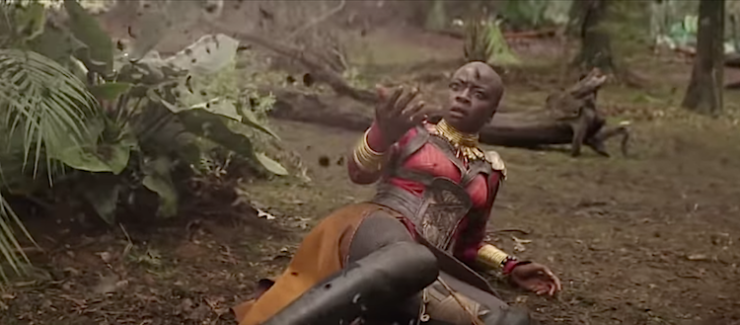
What I’m interested in is this: having merged these visuals and emotional arcs, will Endgame spend any of its nigh-three-hour running time giving us a superpowered version of The Leftovers? Will we be sitting with our characters’ grief? The sense of loss and shock that follows the Snap? Or will they charge ahead into full Avenging mode, to turn the clock back on the End Times?
Leah Schnelbach tried to think of a way to fit Veggietales in here, but it just didn’t work. Maybe for Endgame? Come cancel the apocalypse with them on Twitter!










